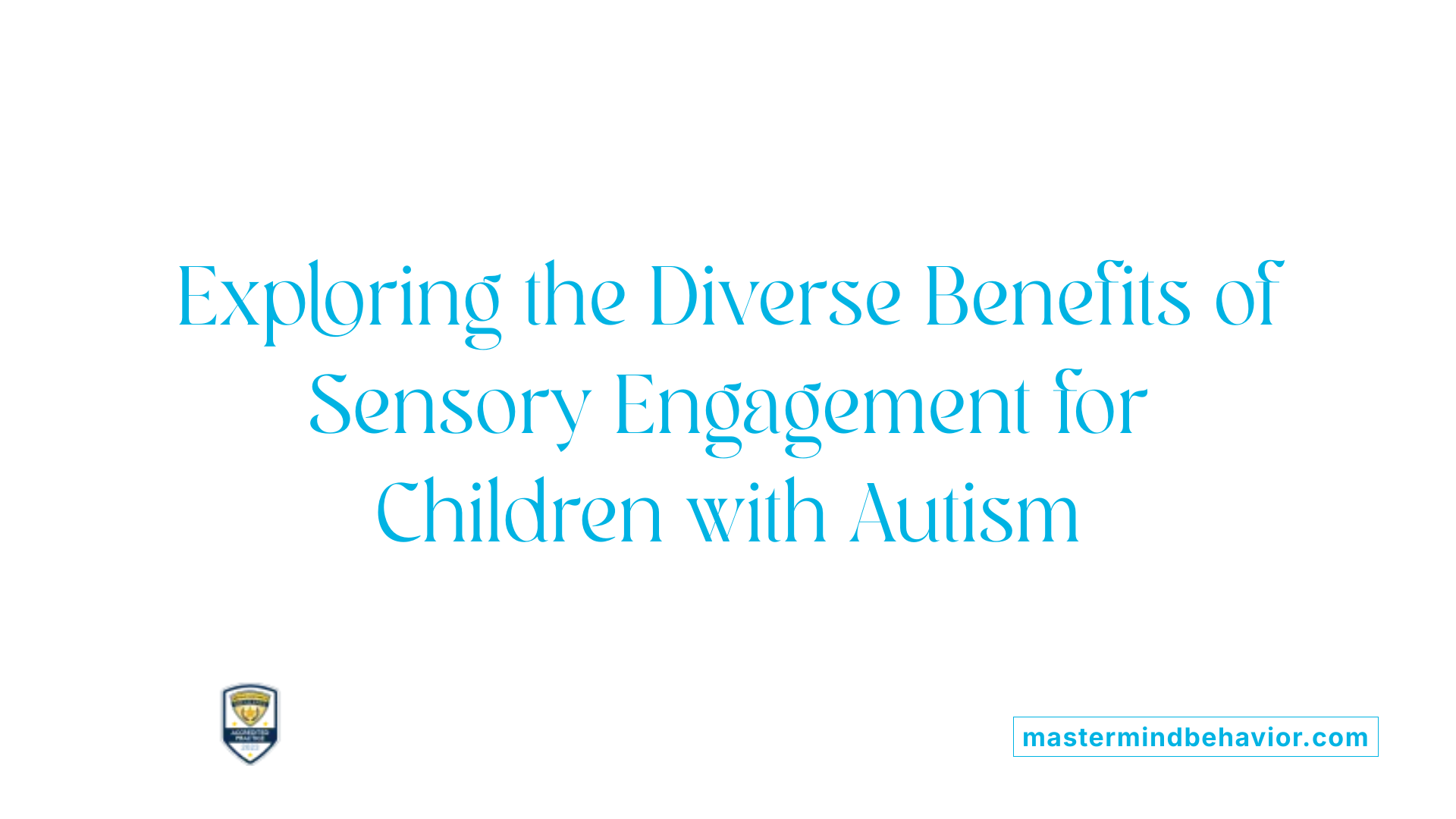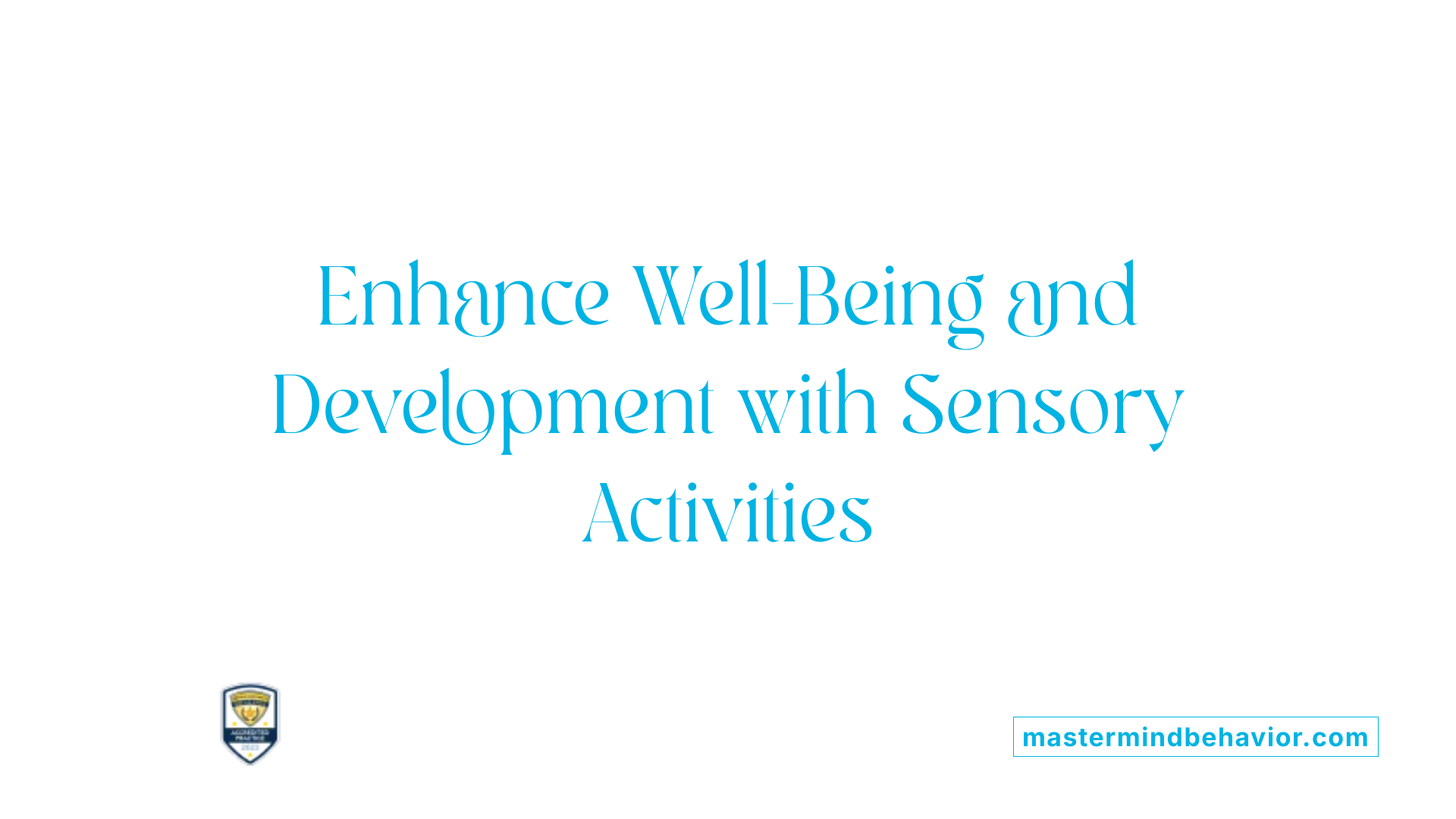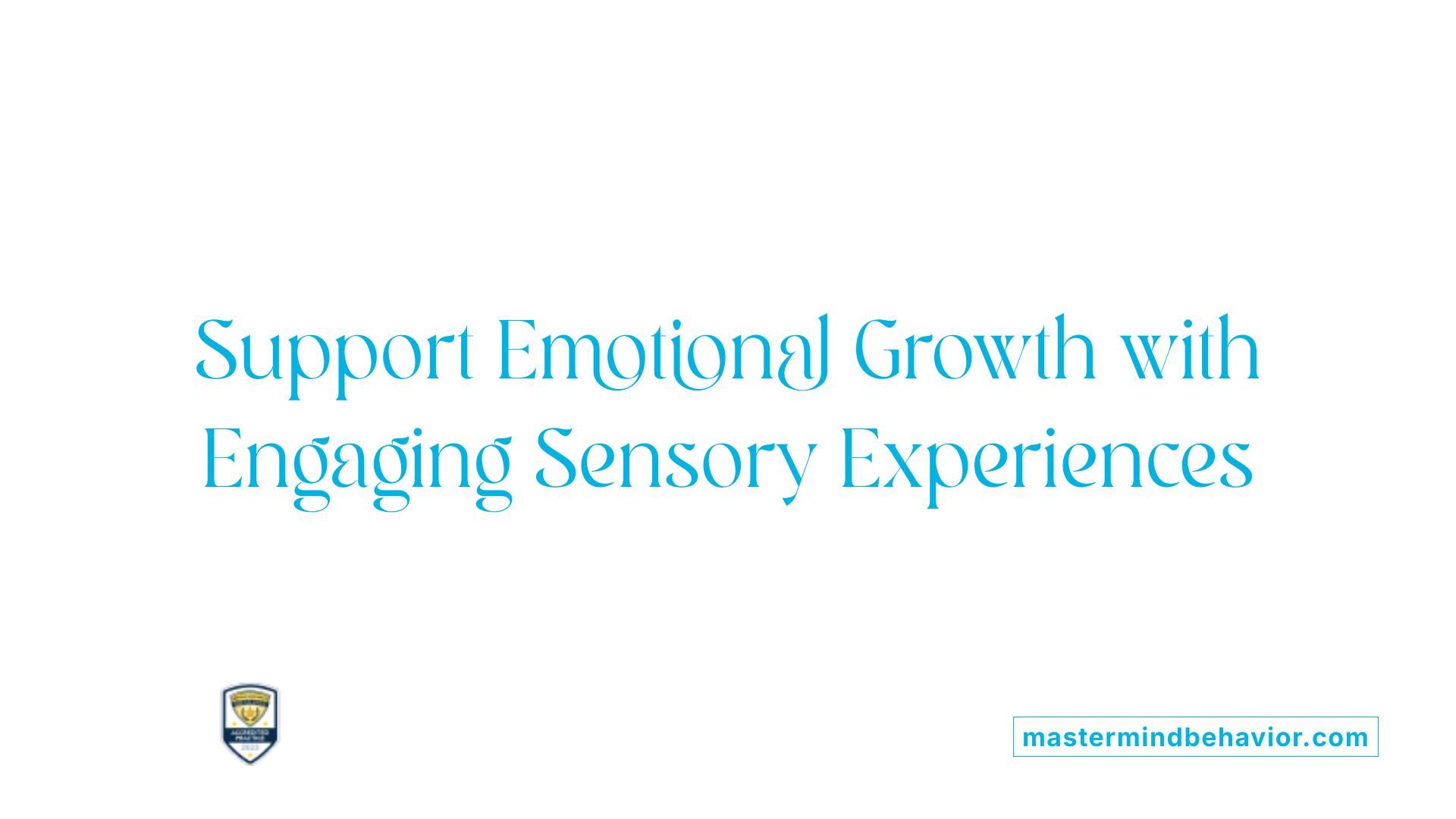Understanding the Role of Sensory Activities in Autism Development
Sensory play has become an integral part of developmental strategies for children with autism. By engaging multiple senses—touch, sight, hearing, smell, and taste—sensory activities facilitate foundational skills in emotional, social, and cognitive domains. This article explores how sensory play supports emotional awareness and regulation, bolsters social skills, and promotes overall development in children on the autism spectrum.
The Multifaceted Benefits of Sensory Play in Autism Development

What are the benefits of sensory play for children with autism?
Sensory play provides extensive advantages that support various areas of development for children with autism. By actively engaging their senses—touch, smell, sight, hearing, and taste—these activities help children make sense of their environment, improving sensory processing skills.
Such play not only boosts a child's physical abilities but also enhances cognitive skills like memory, language, and problem-solving. For example, activities like making slime or taste testing challenge multiple senses and promote neural pathway development.
Emotionally, sensory play offers a calming influence, reducing anxiety and helping children regulate their feelings. It creates a safe space for emotional expression and builds resilience.
Socially, it encourages interaction, turn-taking, and cooperation, fostering communication and relationship-building skills. Participating in group sensory activities, such as building with blocks or sensory paths, strengthens social bonds.
Moreover, sensory activities inspire creativity and imagination, enabling children to explore new ideas and environments with curiosity.
Incorporating sensory play into daily routines, often through a structured sensory diet, can help children with autism maintain focus, improve independence, and promote overall well-being.
In summary, sensory play is a versatile approach that supports physical, cognitive, emotional, and social growth—making it a crucial element in therapies and everyday activities for children with autism.
Why Sensory Play is Vital for Autism Support and Well-Being

Why is sensory play important for children with autism?
Sensory play holds significant value for children with autism by helping them effectively process and regulate sensory information from their environment. These activities, which include engaging with textures, sounds, tastes, and visuals, assist children in understanding and managing their sensory inputs better. As a result, they can experience fewer feelings of overload or anxiety.
Personalization is essential in sensory activities. Tailoring activities to meet individual preferences and sensitivities ensures children remain engaged and comfortable. For example, some children may benefit from calming activities like water play or gentle swinging, while others might seek more stimulating pursuits like jumping or playing with textured materials.
Creating sensory-friendly environments enhances their overall experience. Safe, predictable spaces—such as sensory rooms equipped with calming lights or soft textures—encourage children to explore and engage confidently. This environment allows them to self-regulate and develop emotional resilience.
Furthermore, sensory activities play a key role in developing communication and social skills. As children explore and express through sensory play, they often improve their ability to communicate needs and emotions, fostering better interaction with peers and caregivers.
According to organizations like the Seashell Trust, integrating sensory routines into daily life helps children with autism thrive. These routines provide stability, support emotional regulation, and promote developmental progress. Overall, sensory play is a fundamental component of autism support that nurtures emotional well-being, social engagement, and cognitive growth.
Fostering Emotional Development Through Sensory Experiences

How does sensory play support emotional development in children with autism?
Sensory activities significantly contribute to emotional growth by providing children with autism a way to manage their feelings effectively. Engaging in sensory play helps them regulate their emotions and reduce feelings of stress or overwhelm. For instance, activities like squeezing stress balls or playing with textured materials enable children to release tension and experience calming sensations.
Further, sensory input promotes increased self-awareness. When children explore different textures, sounds, or smells, they learn to recognize and articulate their emotional responses. This process encourages a better understanding of their feelings and helps in coping with complex emotions.
Group-based sensory activities enhance social skills such as sharing and taking turns. Participating in collaborative play fosters empathy and emotional intelligence, facilitating positive interactions with peers.
Neurally, sensory play stimulates multiple brain regions involved in emotional processing, resilience, and problem-solving. These activities reinforce neural connections that support emotional stability and adaptability.
Overall, sensory play offers an enjoyable, flexible approach that nurtures emotional growth comprehensively. It equips children with autism to better understand themselves, connect with others, and develop resilience against everyday emotional challenges.
What are some examples of sensory activities that promote emotional regulation?
- Using weighted blankets or lap pads
- Playing with soft, textured fabrics
- Engaging in water or sensory-rich environments
- Listening to calming music or sounds
- Manipulating playdough or slime
How can sensory play be incorporated into daily routines?
Incorporating simple sensory activities, like providing textured toys or calming noise sessions, into daily routines can create consistent opportunities for emotional regulation. These activities can be personalized based on a child’s preferences and sensory sensitivities, making them both effective and enjoyable.
How does sensory play influence the development of social and emotional skills?
Through shared sensory activities, children learn essential social skills such as turn-taking, cooperation, and non-verbal communication. These experiences help children understand social cues and express their feelings in positive ways, fostering emotional intelligence and resilience.
Implementing Sensory Activities in Daily Routine for Maximum Impact
How can sensory activities be incorporated into daily routines?
Integrating sensory activities into everyday life is essential for supporting children with autism. Regular inclusion can be achieved through simple strategies like using textured fabrics during dressing, offering sensory breaks with activities like jumping or swinging, or using fidget toys during quiet time. These activities do not require lengthy sessions; short, consistent interactions are often most effective. For example, incorporating a sensory bin with rice or beans during playtime or providing a soft, weighted blanket during calming periods helps children regulate their sensory systems naturally throughout the day.
What is the role of sensory diets and structured environments?
A sensory diet is a personalized plan that incorporates various sensory activities tailored to an individual's unique needs. Developed collaboratively by parents, educators, and therapists, it aims to promote self-regulation and prevent sensory overload. Structured environments like sensory rooms or designated calming corners within classrooms create safe spaces where children can engage in sensory activities. These environments often include calming tools such as soft lighting, gentle music, and tactile materials that help children transition between activity and rest effectively.
How to balance calming and stimulating activities?
Balancing calming and stimulating sensory activities is crucial for maintaining emotional and behavioral stability. Calming activities—like slow rocking, water play, or listening to soothing sounds—help reduce anxiety and prepare children for learning or social interactions. Conversely, stimulating activities, such as jumping, textured exploration, or musical games, promote alertness and engagement. A practical approach involves alternating these activities, observing the child's responses, and adjusting intensity as needed. Providing a variety of sensory experiences ensures children can gradually build resilience and adapt to different environments.
How can support from parents, educators, and therapists enhance effectiveness?
Collaboration among parents, teachers, and therapists maximizes the benefits of sensory activities. Training helps caregivers understand how to incorporate sensory strategies tailored to individual needs. For instance, therapists may recommend specific sensory diets or activities suited to a child's sensory profile. Ongoing communication ensures that routines are consistent and adjusted based on progress. Family and school involvement creates a supportive network where sensory regulation becomes a natural part of daily life, fostering greater independence and emotional well-being.
What are the emotional benefits of sensory therapy?
Sensory therapy offers significant emotional benefits by helping individuals better understand and manage their sensory experiences, leading to improved emotional regulation. It can reduce feelings of anxiety, frustration, and overwhelm that often result from sensory overload or sensitivities. Engaging in sensory activities promotes a sense of calm and safety, fostering increased confidence and independence. Additionally, as individuals learn to cope with their sensory needs, they often experience enhanced social interactions and improved self-esteem. Overall, sensory therapy supports emotional well-being by creating a more positive and manageable sensory environment.
| Approach | Strategies Used | Expected Outcomes | Additional Tips |
|---|---|---|---|
| Daily Routine Integration | Short sensory breaks, textured materials, sensory bins | Improved regulation, smoother transitions | Keep activities brief and consistent |
| Sensory Diet Implementation | Personalized plan, professional collaboration | Better self-control, reduced anxiety | Adjust as child's needs evolve |
| Balancing Activities | Alternating calming and stimulating activities | Emotional stability and resilience | Observe and adapt to responses |
| Support System Engagement | Training, communication, joint sessions | Increased independence, better emotional health | Foster teamwork among caregivers |
Incorporating sensory activities thoughtfully and consistently into daily routines can significantly influence emotional regulation and overall development. Whether through a structured sensory diet or simple everyday activities, creating a balance between calming and stimulating experiences supports children with autism in feeling secure, confident, and engaged.
Empowering Children with Autism Through Sensory Engagement
Integrating sensory play into the routines and therapies for children with autism can profoundly impact their emotional awareness, regulation, and social skills. By providing structured and individualized sensory experiences, caregivers and educators can create calming environments that promote confidence, independence, and resilience. As research continues to uncover the neural and developmental benefits of sensory activities, it becomes clear that sensory play is not just fun but a vital tool in fostering emotional growth and holistic development for children on the autism spectrum.
References
- Benefits of Sensory Activities for Children with Autism - ECCM
- Benefits of Sensory Play at Home for Your Child with Autism
- Play therapy in children with autism: Its role, implications, and ...
- Benefits of Sensory Therapy – Promoting Emotional Well-Being ...
- Benefits of Sensory Therapy for Autistic Individuals
- The Importance of Sensory Activities for Children with Autism -
- Nurture Social and Emotional Skills with Sensory Playtime
- How do Sensory Activities help Autism? - The Seashell Trust
- How Does Sensory Play Help People With Autism? - Strides ABA









